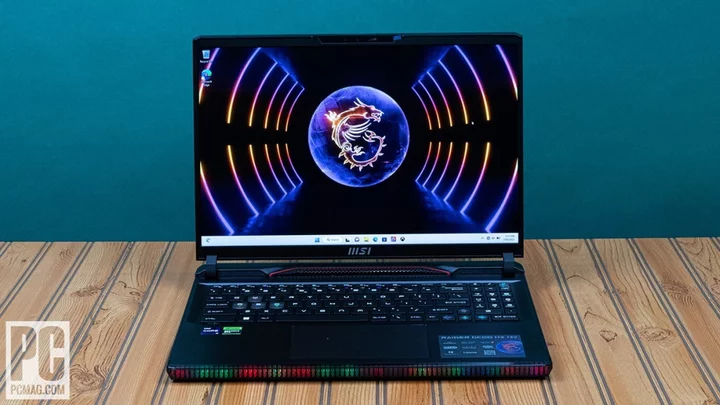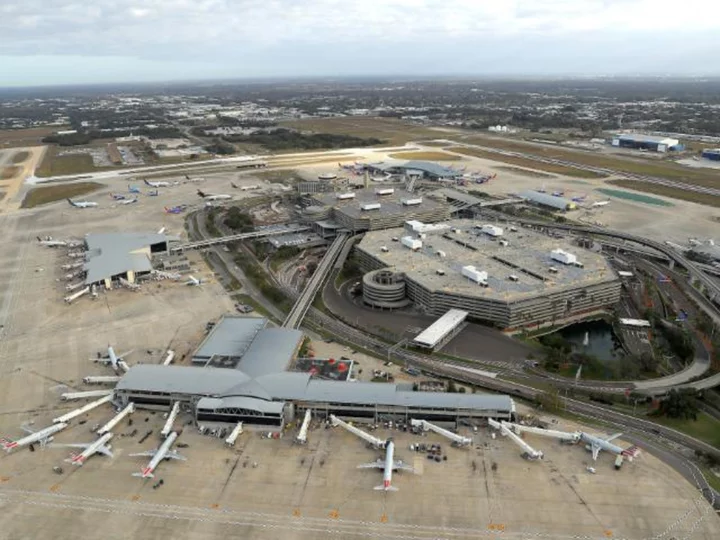MSI has a heavyweight on its hands with the $1,799 Costco-exclusive Raider GE68HX 13VF. This is a well-built gaming laptop with a powerful Intel Core i9 HX-series processor and an Nvidia GeForce RTX 4060 graphics chip. That relatively low starting price for this mighty configuration helps the Raider GE68HX 13VF stand out, proving itself as an exciting alternative in midrange gaming laptops, a field Lenovo has dominated with the likes of the Editors' Choice-award-winning Lenovo Legion Slim 5 Gen 8 and the Lenovo Legion Pro 5 Gen 8. A better screen in our test machine might have sent this Raider over the top.
The Design: Built Like a Higher-End Machine
The MSI Raider GE68HX 13VF isn’t like some of the Raiders of old. MSI, PCMag's leading Readers' Choice brand for laptops, has made it trimmer, shaving down a bit of the bulk that’s common on 16-inch gaming laptops such as this. It’s still a sizable machine, measuring 1.1 inches thick and weighing just a hair under 6 pounds, but it's within reason for a 16-inch laptop packing high-power components and the necessary cooling hardware.
On trend, the Raider has a display hinge that's shifted forward, with a protruding tail end that houses extra cooling and some rear ports. This adds a bit to the depth (at about 11.2 inches), which can make the laptop a bit hard to fit into bags and backpacks.
Despite the move toward a leaner machine, the Raider still packs plenty. It fits in a 99-watt-hour battery (as big as they come), and it has a number pad alongside its keyboard, though it’s notably squished into a small space alongside shrunken arrows and a diminutive right shift key. Those keys all provide per-key RGB lighting. MSI even squeezed in a pair of top-firing 2-watt speakers that sit in close proximity to a second pair of side-firing ones, giving it a leg up on the competition audio-wise.
MSI also loaded in a Windows Hello-capable webcam above the display with a physical privacy shutter. It’s a 1080p camera, which makes for a pleasantly sharp picture under decent lighting, though its image is a bit grainy in anything less than bright conditions.
(Credit: Molly Flores)Even the port selection is broad, fitting three USB 3.2 Gen 2 ports, two Type-A and one Type-C, which supports charging and DisplayPort output, on the right side. The left edge of the laptop features an audio combo jack, a full-size SD card reader, and a Thunderbolt 4 port.
Just from these ports, this laptop would already have a broad and varied array, but the rear edge of the laptop adds another USB-C 3.2 Gen 2 port, an HDMI 2.1 output, an Ethernet jack, and a dedicated DC input for charging. Wi-Fi 6E and Bluetooth 5.3 supplement those wired connections, giving the Raider a serious selection of connectivity.
(Credit: Molly Flores)MSI squeezed all of this into a decent frame with a plastic underside but an aluminum keyboard deck and display lid, making for a relatively high-quality and sturdy feel. The display hinge is also firm, holding the monitor still without much wobble. However, the hinge pivots into a rather sizable slot with a small opening (about the size of a USB-A port) that could trap debris.
Looking for RGB? MSI also added some flair with an LED light bar at the front edge of the laptop, with many individually addressable zones and an RGB-lit MSI logo on the lid. Though the zones blend together somewhat, it still makes for a colorful contrast to the otherwise blackout scheme of the machine. You'll also find a few ribbed areas around the machine that give it more of an industrial feel. And MSI subtly snuck its logo into the molded plastic and speaker grates.
(Credit: Molly Flores)While these aspects of the MSI Raider GE68HX are identical among configurations, MSI has a wide range of options to choose from that vary in internal components and display. It starts at $1,799 for the model tested here (a Costco exclusive), which has a Core i9-13950HX CPU and an RTX 4060 GPU alongside 32GB of DDR5 memory and 1TB of storage. This configuration also includes a 1,920-by-1,200-pixel, 144Hz display with a limited color gamut (exclusive to this Costco model). All other configurations include a 2,560-by-1,600, 240Hz display with a claimed 100% coverage of the DCI-P3 color space. These configurations range in price from $2,299 to $3,499 and include varying combinations of Core i9-13950HX or Core i9-13980HX; RTX 4060, 4070, or 4090; 16GB or 32GB of RAM; and a 1TB or 2TB SSD.
Largely a Pleasure to All But the Eyes
MSI has installed a solid-feeling keyboard on the Raider. The keys are fairly firm, providing enough resistance to not feel wobbly. They don’t have much in the way of contoured tops, so it can be a little tricky to center my fingers on them by feel, but that didn’t prevent me from comfortably reaching a typing speed of 110 words per minute with 98% accuracy, as measured in Monkeytype. The RGB backlight, shining through the full keycap legends, is highly visible in the dark. However, the keyboard layout makes the board more tedious to use for browsing, navigating, editing, and data entry.
This laptop's touchpad is large and smooth, making for pleasant navigation. It has a gentle click when depressed and an even feel.
(Credit: Molly Flores)For everything the Raider has going for it, the display (exclusive to this configuration) is not one of them. While its 16-inch size and anti-glare finish make it useful enough by nature, it isn’t impressively bright, and it tops out at an underwhelming 144Hz refresh rate with no variable refresh rate capability. The panel also has a limited color range, and it's just overall not that pleasant to look at.
At least the Raider pumps out punchy audio. While many of the gaming laptops I’ve tested recently have delivered somewhat flat sound from bottom-firing speakers, the Raider actually combines four speakers that make for a fuller sound. The Nahimic software further enhances the audio produced and can extend to a paired Bluetooth speaker for a surround-like effect. While the bass isn’t as fat or as powerful as I’d like for gaming, movies, or music, you'll find enough audio chops here for pleasant listening.
MSI included just a few pre-installed apps beyond what normally comes with a Windows installation, almost all for managing its hardware and lighting. Most are useful or essential, with only one feeling unnecessary—a tool for running Android apps called MSI App Player 5.
Testing the MSI Raider GE68HX 13VF: Putting a Pro-Grade Processor Up to Some Games
With its Intel Core i9-13950HX CPU and RTX 4060 GPU, the Raider GE68HX 13VF contains potent hardware, but you'll find plenty of powerful laptops that can run against it at comparable prices. The Lenovo Legion Pro 5 Gen 8 ($1,839 as tested) is an outstanding machine, packing a more powerful GPU for the money. For something a little slimmer, Lenovo's Legion Slim 5 Gen 8 ($1,549 as tested) matches the Raider's GPU and has a powerful AMD processor—at a lower price.
We also included two systems from the other end of the spectrum focused on portability. The MSI Stealth Studio 14 ($1,899.99 as tested) runs a slower processor and has half the RAM while costing $100 more; it’s a much smaller machine. Portability also costs a premium in the 2023 Razer Blade 14 ($2,699 as tested), which makes up for this somewhat with an RTX 4070 and a high-end AMD processor.
Productivity and Content Creation Tests
For every mobile and desktop system we test, we run a suite of productivity benchmarks. The first of these is UL's PCMark 10, which simulates a variety of real-world productivity and office workflows to measure overall system performance and also includes a storage subtest for the primary drive.
Three additional benchmarks target the CPU specifically, using all available cores and threads, to rate a PC's suitability for processor-intensive workloads. Maxon's Cinebench R23 uses that company's Cinema 4D engine to render a complex scene, while Geekbench 5.4 Pro from Primate Labs simulates popular apps ranging from PDF rendering and speech recognition to machine learning. Finally, we use the open-source video transcoder HandBrake 1.4 to convert a 12-minute video clip from 4K to 1080p resolution (lower times are better).
We round out the productivity testing with PugetBench for Photoshop by workstation maker Puget Systems, which uses the Creative Cloud version 22 of Adobe's famous image editor to rate a PC's performance for content creation and multimedia applications. It's an automated extension that executes a variety of general and GPU-accelerated Photoshop tasks ranging from opening, rotating, resizing, and saving an image to applying masks, gradient fills, and filters. Unfortunately, this system was unable to run the test due to ongoing compatibility issues.
The Raider is a monster of a machine, thanks in large part to its CPU. Despite being one of the cheaper systems here, the Raider left the competition in the dust in our CPU-specific tests, with the fastest render speed in HandBrake and the highest Geekbench score we’ve seen from a Windows laptop to date. Its Cinebench score was also among the top few systems we’ve tested, outpaced by only a few running the Intel Core i9-13980HX or AMD Ryzen 9 7945HX. With this kind of performance, the Raider's competitors were largely left behind. For CPU-based workloads, this is one mighty laptop.
In PCMark 10’s productivity test, systems that score more than 4,000 points are accepted as highly capable for everyday use by PCMag, so breaking 8,000 is a telling sign this system won’t struggle with much. However, the Raider lost the lead in both PCMark tests, likely due to its comparatively weaker SSD.
The MSI Raider GE68HX 13VF’s SSD has limited speeds, clearly not taking full advantage of the PCIe 4.0 x4 bandwidth available to it. An anecdotal CrystalDiskMark test measured sequential reads at 4,701MB/s and sequential writes at 3,477MB/s. High-end PCIe 4.0 SSDs can hit above 7,000MB/s in sequential read speeds and close to 7,000MB/s in write speeds. This system comes with the Micron 2400 SSD, a PCIe 4.0 drive that uses cheaper and lower-durability QLC NAND than you’d get in premium drives like the Samsung 990 Pro or SK Hynix Platinum P31. The Raider has a second M.2 slot for extra capacity, though, if you'd like to bulk up the storage after the fact.
Graphics and Gaming Tests
We task gaming laptops and mobile gaming devices with an extra round of tests consisting of both synthetic and real-world gaming benchmarks. The former includes two DirectX 12 gaming simulations from UL's 3DMark, Night Raid (more modest, suitable for systems with integrated graphics) and Time Spy (more demanding, suitable for gaming rigs with discrete GPUs). The cross-platform GPU benchmark GFXBench 5 comes next, which we use to gauge OpenGL performance. These GFXBench tests are rendered offscreen to accommodate different native display resolutions; more frames per second (fps) means higher performance.
To further stress mobile GPUs, we follow up the synthetic tests with the in-game benchmarks of F1 2021, Assassin’s Creed Valhalla, and Rainbow Six Siege. These three games—all benchmarked at 1080p resolution—represent simulation, open-world action-adventure, and competitive/esports shooter games, respectively. Valhalla and Siege are run twice (Valhalla at Medium and Ultra quality, Siege at Low and Ultra quality), while F1 2021 is run once at Ultra quality settings and, for Nvidia GeForce RTX-based systems, a second time with Nvidia’s performance-boosting DLSS anti-aliasing turned on.
Across synthetic and in-game benchmarks, we see a couple of things clearly. The RTX 4060 is a competent GPU for laptop gaming, and between the capable cooling of the MSI Raider GE68HX 13VF and the powerful CPU staving off bottlenecking, it can sometimes catch up with an RTX 4070 that’s held back by thermal constraints. This showed in the way the Raider was nearly able to keep up with (and occasionally surpass) the Razer Blade 14’s RTX 4070 in 3DMark Time Spy, F1 2021, Assassin’s Creed, and Rainbow Six Siege. The Raider's cooling, combined with a speedier CPU, helped keep it consistently a hair ahead of the MSI Stealth Studio 14, which had to fit the same GPU into tighter confines.
The Raider's CPU advantage was also made clear in 3DMark Night Raid, in which it led the pack by a distant figure. (Night Raid measures CPU simulation performance in addition to graphics rendering.)
However, the Raider failed to outperform the Legion laptops at times, despite its GPU tuned to 140W of total graphics power, or TGP. The Lenovo Legion Slim 5 Gen 8 is a more compact machine, but it still managed to trade blows with the Raider despite its weaker CPU and its RTX 4060 tuned to just 100W.
And though the Raider sparred with the 140W, RTX 4070-powered Lenovo Legion Pro 5 Gen 8 in gaming performance, it did trail it by noticeable margins. This happened even in situations where its CPU advantage might have helped even the odds, like the low-settings test of Rainbow Six Siege, which shifts more of the workload onto the CPU. At the same TGP, it makes sense for the RTX 4070 to outpace the RTX 4060.
Battery and Display Tests
We measure laptop battery life by making sure the system is fully charged, turning off Wi-Fi and keyboard backlighting, and playing a locally stored 720p video (the open-source Blender movie Tears of Steel) with Windows display brightness set to 50% and audio volume to 100% until the system quits.
We also assess display performance and capabilities using a Datacolor SpyderX Elite monitor calibration sensor and its software to measure the display's color saturation—what percentage of the sRGB, Adobe RGB, and DCI-P3 color gamuts or palettes the screen can show—and its 50% and 100% brightness in nits (candelas per square meter).
As previously mentioned, the Raider's display is severely lacking. While the rest of the laptops in our comparison set employ decent displays that even edge on excellent, thanks to high brightness levels and wide coverage of color gamuts punching up all content, the Raider covered just 67% of the sRGB color space. That’s no different than what you might find on a budget machine. Its 1200p resolution is also not nearly as sharp as some of the panels with 1600p resolutions on 16-inch machines. Plus, 144Hz is the refresh-rate low end of the spectrum for gaming displays these days.
To top it off, the Raider's display was the dimmest of the bunch, topping out at a usable but unexceptional 332 nits. It’s bright enough when cranked way up, but not exciting to look at. It's worth remembering that this display is exclusive to the Costco configuration tested here; all other configurations of this machine include a significantly upgraded display.
What it lacks in display quality, the Raider somewhat makes up for in battery life, able to run our battery test for 7 hours and 36 minutes before the system shut down. Many gaming laptops, including those included here, generally last around 6 hours, so the Raider scores a healthy lead. It was only beaten in this lot by the Razer Blade 14, which netted a truly impressive 10 hours and 35 minutes, unexpected for a compact gaming laptop. The Raider's lead over the Lenovo laptops is all the more marked given that MSI runs its display brighter at the 50% level used in our test than the exceedingly dim settings Lenovo laptops use.
(Credit: Molly Flores)Verdict: A Workhorse That Gamers Can Get Behind
The Raider GE68HX 13VF is an intriguing if flawed confluence, set apart by its powerful hardware. It may not be the most effective gaming machine you can get for the price, but it makes up for that with a bit of extra curb appeal and a heap of CPU performance that can help it excel as a workstation during the day and gaming machine at night (ideally with an external monitor). The Costco-exclusive model's $1,799 price is one of its more compelling aspects (and its screen one of its least), as the higher-spec configurations will make for unfavorable races with Lenovo’s higher-end Legion laptops.









